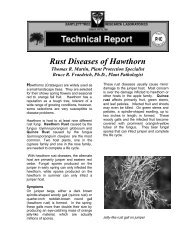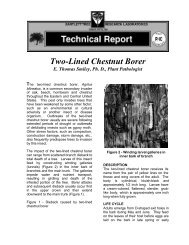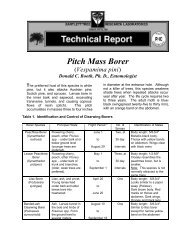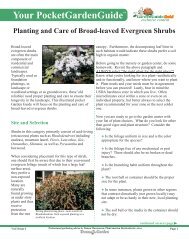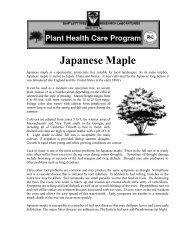PHYTOPHTHORA ROOT ROT NH12-99 - Online Gardener
PHYTOPHTHORA ROOT ROT NH12-99 - Online Gardener
PHYTOPHTHORA ROOT ROT NH12-99 - Online Gardener
You also want an ePaper? Increase the reach of your titles
YUMPU automatically turns print PDFs into web optimized ePapers that Google loves.
Phytophthora Root Rot and<br />
Collar Rot of Landscape Plants<br />
E. Thomas Smiley, Ph. D., Plant Pathologist,<br />
Bruce R. Fraedrich, Ph. D., Plant Pathologist,<br />
Thomas R. Martin, Plant Protection Specialist<br />
Phytophthora Root Rot<br />
Phytophthora root rot is a widespread but<br />
often overlooked disease of landscape<br />
plants. Several species of Phytophthora<br />
attack the fine absorbing roots of plants and<br />
may invade larger roots and the root collar.<br />
The name Phytophthora is a Greek work<br />
literally meaning “plant destroyer”. These<br />
fungi grow in the cambium and sapwood<br />
causing death of the tissue. Loss of water<br />
and nutrient absorbing capacity and stored<br />
carbohydrate reserves in the root cause a<br />
gradual, or sometimes-rapid decline of the<br />
above ground portion of the plant.<br />
Phytophthora is a water mold therefore<br />
diseases caused by these fungi are most<br />
common on soils that are poorly drained or<br />
receive excessive irrigation. Root rot is<br />
common on newly developed sites where the<br />
soil was severely disturbed or compacted<br />
from construction activities. Phytophthora<br />
also is a common disease in nurseries.<br />
Decline and death of new plantings may<br />
result from outplanting diseased stock.<br />
Hosts<br />
Root and root collar rots commonly affect<br />
plant species that are intolerant of poor soil<br />
drainage. The disease is common on the<br />
following species:<br />
Azalea<br />
Rhododendron<br />
Japanese holly<br />
Boxwood<br />
Hemlock<br />
Mountain Laurel<br />
Dogwood<br />
Andromeda<br />
Fir (Abies)<br />
Camellia<br />
White Pine<br />
Taxus<br />
Phytophthora is responsible for the root<br />
collar rots of woody ornamentals. Plants with<br />
soil or mulch covering their root collar are<br />
very susceptible to rot.<br />
Oaks, beech, rhododendron, fruit trees<br />
(Prunus, Malus, Citrus, Avocado), dogwood,<br />
sugar and red maple and Zelkova are<br />
particularly prone to collar rot from buried<br />
root collars.<br />
Several species of Phytophthora attack<br />
woody ornamentals. The pathogen P.<br />
cinnamomi commonly causes root rot while<br />
P. cactorum attacks root collars and stems.<br />
Phytophthora is a soil borne fungus, which<br />
overwinters or persists in soil or on dead<br />
plant material as mycelium (the vegetative<br />
stage of fungi) or thick-walled resistant<br />
spores (oospores). Oospores can remain
viable for many years. When soils are moist,<br />
oospores germinate and mycelium form<br />
reproductive structures call sporangia.<br />
These sporangia release mobile zoospores<br />
when soils are saturated with water.<br />
Zoospores use a flagella to swim to<br />
susceptible root tissues or may be<br />
transported longer distances in runoff.<br />
Zoospores are attracted to plant metabolites<br />
exuded from plant roots. Once spores<br />
contact succulent plant tissue or wounds,<br />
they germinate and mycelium invades host<br />
tissue. Infection is favored by warm<br />
temperatures (>65?F) and free water.<br />
Plants under stress from drought, defoliation,<br />
low soil aeration, root collar disorders or<br />
other stress agents are most prone to<br />
Phytophthora root and collar rot. Stress<br />
stimulates secretions of metabolites by plant<br />
roots, which increases the likelihood of<br />
infection by Phytophthora.<br />
Phytophthora is a poor saprophyte and is<br />
usually quickly overgrown by secondary<br />
microorganisms after plant tissue is killed. In<br />
these instances, Phytophthora will form<br />
survival structures (oospores) in dead tissue<br />
or soil. When soil moisture and temperature<br />
conditions favor disease development,<br />
Phytophthora can increase rapidly from<br />
undetectable levels in the presence of a host<br />
plant.<br />
Symptoms<br />
Symptoms of root rot vary depending on the<br />
susceptibility of the plant species, the<br />
virulence of the specific Phytophthora<br />
species and site (environmental) conditions.<br />
A chronic form of the disease causes a slow,<br />
progressive decline. Symptoms include a<br />
reduction in shoot growth; small leaves,<br />
thinning of the crown, chlorosis, twig and<br />
branch dieback and eventually death.<br />
Diseased roots are reddish brown and brittle.<br />
These symptoms are often confined to fine<br />
roots and lateral roots less than ¼” diameter.<br />
Decline occurs over a period of months or<br />
years before death occurs.<br />
Rapid wilting and death of the entire plant<br />
characterize the acute form of the disease.<br />
Leaves turn red then brown and usually<br />
remain attached. Affected fine and large<br />
roots are reddish brown and brittle.<br />
Phytophthora lesions may extend into the<br />
root collar, which causes girdling of the stem<br />
and rapid collapse of the crown.<br />
Diagnosis/Confirmation<br />
Infection can occur months or years ahead<br />
of first visible symptoms. On some plant<br />
species, symptoms do not appear until root<br />
or collar rot is advanced. When<br />
Phytophthora is found on a declining plant, it<br />
is likely to be the agent causing the problem,<br />
or at least, a significant contributing factor.<br />
On plants suspected to be infected with<br />
Phytophthora, collect affected roots, place in<br />
a plastic bag and submit to a plant diagnostic<br />
laboratory. Where lesions exist on the root<br />
collar, sample affected sapwood tissue from<br />
margins of the root collar and submit for<br />
analysis. Affected tissue can be cultured for<br />
Phytophthora using standard microbiological<br />
techniques or analyzed using an ELISA test.<br />
ELISA test kits are also available for<br />
immediate “in-field” analysis of plant tissue.<br />
Disease Management/Prevention<br />
Where soils are poorly drained and prone to<br />
inundation/flooding, use species that are<br />
tolerant to these soil conditions. Most<br />
moisture tolerant species are resistant to<br />
root rot or tolerate this disease. Tables 1 and<br />
2 list common woody plants that are tolerant<br />
of poor soil drainage. Check hardiness of<br />
each species prior to planting in your<br />
geographic area.<br />
Ensure the root collar is exposed and free of<br />
soil and mulch. Even species that tolerate<br />
poor drainage such as red maple and<br />
Zelkova are subject to collar rot when root<br />
flares are buried.<br />
When using susceptible species in poorly<br />
drained soils create raised beds or provide<br />
sub-surface drainage. Plant with the root<br />
collar exposed. If soil is compacted, prepare<br />
planting area by cultivating and incorporating<br />
organic matter.<br />
BTRL 12/<strong>99</strong> TR-63<br />
2
Avoid excessive mulch on susceptible<br />
species. A two-inch maximum mulch depth<br />
is recommended. Favor coarse mulches<br />
such as bark nuggets or wood chips. Avoid<br />
shredded bark products that tend to compact<br />
and hold water.<br />
Irrigate as needed to maintain soil moisture,<br />
but not to excess. Use tensiometers to<br />
monitor soil moisture.<br />
Phytophthora sensitive species planted on<br />
sites subject to saturated soils may require<br />
periodic treatment (annual to biannual) with<br />
fungicides to minimize new infections.<br />
Remedial Treatments<br />
Plants exhibiting chronic disease symptoms<br />
should be treated with an approved fungicide<br />
for managing Phytophthora. Treating<br />
surrounding susceptible plants on a<br />
preventative basis also is recommended.<br />
Repeat applications are recommended when<br />
soils are prone to saturation and<br />
temperatures favor infections. Consult<br />
Bartlett Pest Management<br />
Recommendations for fungicide, rates,<br />
timing and techniques for treating<br />
Phytophthora.<br />
Improve soil drainage as needed; proper<br />
mulching, irrigation and root collar<br />
excavation as outlined under preventative<br />
treatments are recommended to reduce the<br />
incidence and severity of the root rot.<br />
Where soils are poorly drained and/or<br />
subject to inundation, consider moving<br />
Phytophthora sensitive species to areas with<br />
good drainage. Replant poorly drained bed<br />
with species from Tables 1 and 2.<br />
Table 1. SHRUBS FOR POORLY DRAINED SOIL (Phytophthora root rot tolerant)<br />
Common Name Botanical Name<br />
Florida Anise Illicium floridanum<br />
Sarccocca Sarcococa hookerana<br />
Viburnum species Viburnum spp.<br />
Inkberry holly Ilex glabra<br />
Yaupon holly Ilex vomitoria<br />
Winterberry holly Ilex verticillata<br />
Chinese witchhazel Hamamelis virginiana<br />
Butterfly Bush Buddleia davidii<br />
Sweetshrub Calycanthus floridus<br />
Summersweet clethra Clethra alnifolia<br />
Crapemyrtle Lagerstroemia indica<br />
Mockorange Philadelphus coronarius<br />
Arborvitae Thuja spp.<br />
BTRL 12/<strong>99</strong> TR-63<br />
3
Table 2. TREES FOR POORLY DRAINED, CLAY SOILS AND URBAN AREAS<br />
Common Name Botanical Name<br />
Amur Maple Acer ginnala<br />
Hedge Maple Acer campestre<br />
Red Maple Acer rubrum*<br />
River Birch Betula nigra*<br />
European Hornbeam Carpinus betulus<br />
Hackberry Celtis occidentalis*<br />
Cockspur Hawthorne Crateagus crusgalli<br />
Leyland Cypress x Cupressocyparis leylandii<br />
Hardy Rubber Tree Eucommia ulmoides<br />
Ash Fraxinus sp.<br />
Ginkgo Ginkgo biloba<br />
Thornless Honeylocust Gleditsia triacanthos ‘inermis’<br />
Crapemyrtle Lagerstomeia indica<br />
Sweetgum Liquidambar styraciflua*<br />
Crabapple Malus spp. (use disease resistant cultivars)<br />
Metasequoia Metasequoia glyptostroboides<br />
Blackgum Nyssa sylvatica*<br />
Norway Spruce Picea abies<br />
White Spruce Picea glauca<br />
London Plane Tree Platanus x acerifolia*<br />
Callery Pear Pyrus calleryana (use cultivars)<br />
Sawtooth Oak Quercus acutissima<br />
Swamp White Oak Quercus bicolor<br />
Willow Oak Quercus phellos*<br />
Japanese Pagodatree Sophora japonica<br />
Baldcypress Taxodium distichum*<br />
Arborvitae Thuja occidentalis<br />
Lacebark Elm Ulmus parvifolia*<br />
Japanese Zelkova Zelkova serrata*<br />
* Tolerates temporary flooding<br />
BTRL 12/<strong>99</strong> TR-63<br />
4



